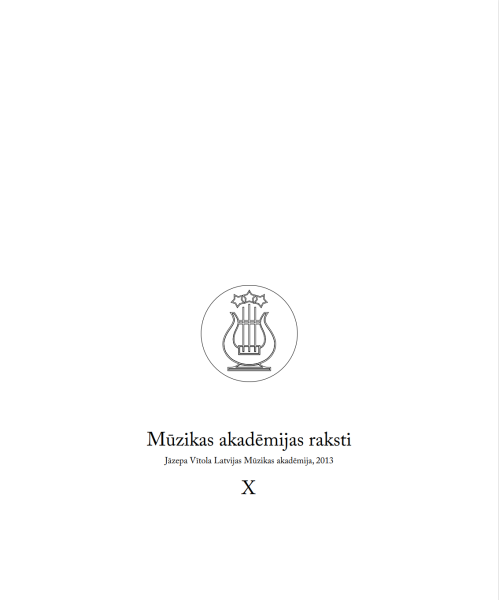RECORDED MUSIC – ASPECTS OF PERCEPTION
Keywords:
music recording, sound, live performance, music perceptionAbstract
The main aim of this article is to research the effect of music recording technology on the environment of performing arts, particularly classical music performers and the audience. Due to the rapid development of technology, music recordings today are more than just captured sound, they set higher musical standards and develop the musical taste of the audience. In this article, I intend to investigate the attitude of performers and listeners towards recordings and live performance, and the differences in music perception.
Downloads
References
Bazzana, Kevin (2004). Wondrous Strange. The Life and Art of Glenn Gould. Oxford: Oxford University Press Beardsley, Roger & Daniel Leech-Wilkinson (2009). A Brief History of Recording to ca. 1950. http://www.charm.kcl.ac.uk/history/p20_4_1.html (skatīts 2013. gada 1. martā)
Berman, Boris (2000). Notes from the Pianist’s Bench. New Haven, London: Yale University Press
Daniels, Robin (1979). Conversations with Menuhin. London: Macdonald General Books
Day, Timothy (2000). A Century of Recorded Music: Listening to Musical History. New Haven, London: Yale University Press
Dunsby, Jonathan (2001). Performance. The New Grove Dictionary of Music and Musicians. Second Edition. Edited by Stanley Sadie. Executive Editor John Tyrrell. Volume 19. London, etc.: Macmillan Publishers Limited, pp. 346–349
Godin, Seth (2011). Why We Prefer Live. http://sethgodin.typepad.com/seths_blog/2010/11/why-we-prefer-live.html (skatīts 2011. gada 15. novembrī)
Katz, Mark (2010). Capturing Sound. How Technology has Changed Music. Berkeley and Los Angeles: University of California Press
Klotiņa, Inese (2012). Intervija. Tatjanas Ostrovskas pieraksts. Rīga, Lielā Ģilde, 13. jūlijs
Krippendorff, Klaus (2004). Content Analysis: An Introduction to Its Methodology. Thousand Oaks: SAGE Publications
Lawson, Colin (2002). Performing through history. In: John Rink (ed.). Musical Performance. A Guide to Understanding. Cambridge: Cambridge University Press, pp. 3–14
Ļahovskis, Antons (2012). Intervija. Tatjanas Ostrovskas pieraksts. Londona, Gildholas Mūzikas un Drāmas skola, 20. septembris
Neuendorf, Kimberly (2002). The Content Analysis Guidebook. Thousand Oaks: SAGE Publications
Philip, Robert (1992). Early Recordings and Musical Style: Changing Tastes in Instrumental Performance, 1900–1950. Cambridge: Cambridge University Press
Philip, Robert (2004). Performing Music in the Age of Recording. New Haven, London: Yale University Press
Rosen, Jody (2008). Researchers play tune recorded before Edison. The New York Times. March 27
Rosa, Žaklīna (2012). Intervija. Tatjanas Ostrovskas pieraksts. Londona, Gildholas Mūzikas un Drāmas skola, 12. novembris
Ross, Alex (2005). The record effect. How technology has transformed the sound of music. The New Yorker. June 6
Sloboda, John (2005). Exploring the Musical Mind. Oxford: Oxford University Press
Schutz, Michael & Scott Lipscomb (2007). Hearing gestures, seeing music: Vision influences perceived tone duration. Perception 36 (6). London: Pion, pp. 888–897
Šnē, Normunds (2013). Intervija. Tatjanas Ostrovskas pieraksts. Rīga, Spīķeri, 26. februāris
Švolkovskis, Juris (2013). Intervija. Tatjanas Ostrovskas pieraksts. Rīga, Jāzepa Vītola Latvijas Mūzikas akademija, 10. februāris
Taruskin, Richard (1995). Text & Act. Essays on Music and Performance. Oxford: Oxford University Press
Upatnieks, Egils (2013). Intervija. Tatjanas Ostrovskas pieraksts. Rīga, Lielā Ģilde, 15. februāris
Znotiņš, Armands (2013). Skaņu nospiedumi vaskā (1). http://www.satori.lv/raksts/5506/Armands_Znotins/Skanu_nospiedumi_vaska (skatīts 2013. gada 1. decembrī)
Downloads
Published
Issue
Section
License
Copyright (c) 2024 Mūzikas akadēmijas raksti

This work is licensed under a Creative Commons Attribution 4.0 International License.


